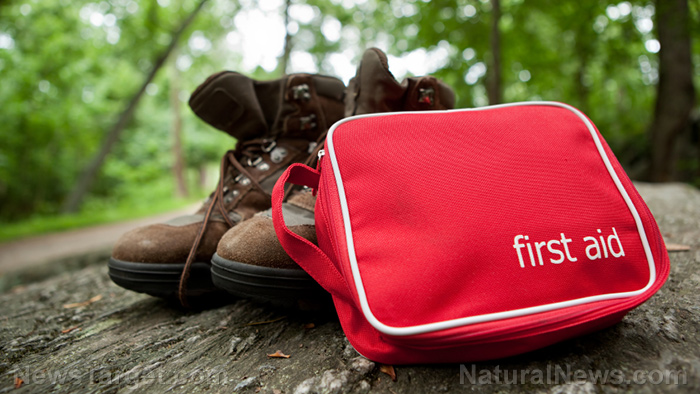These are the items that you need in your first-aid kit if you just want to carry the bare minimum
05/13/2018 / By Zoey Sky

A first-aid kit is something that you always want to keep in your survival gear, even if you dread ever having to use it. If you want to keep your pack light, you can prepare a basic first-aid kit so you have something to treat minor cuts and scrapes.
While you can get various kinds of prepackaged medical kits, most of them often contain items that you may not need. The best thing to do is make your own first-aid kit so you can include items that suit your personal preferences. (h/t to GearJunkie.com)
Items for your basic first-aid kit
The list below includes items that ER doctor and adventure racer Jason Quinn has in his backcountry kit. Dr. Quinn notes that his kit, while sufficient for addressing minor injuries when cycling, doesn’t contain that many things to begin with. Feel free to add items to this list:
- 1 elastic bandage (e.g. ACE wrap)
- 1 4×4″ gauze bandages
- 1 roll of adhesive tape
- 1 triangle bandage
- 4 doses of antihistamine
You can add the following items if you still have space in your first-aid kit:
- Anti-diarrhea – Add anti-diarrhea medicine like Imodium, or you can use some kratom leaves. Kratom is a natural anti-diarrheal. You can also buy some powdered kratom for your kit instead.
- Anti-heartburn – Add some Tums or some aloe vera juice, which can soothe an upset stomach.
- Anti-nausea – Ondansetron won’t make you feel drowsy, unlike other antiemetics. Ginger is a natural alternative for anti-nausea medicine.
- Electrolytes – When you get cramps and lose minerals while cycling, you will need to replenish your electrolytes.
- EpiPen – Carry an EpiPen in your first-aid kit, especially if you have an identified anaphylactic response. This item might just save your life.
- Extra tape – Tape is versatile, and you can use it as a bandage, for blisters, or to repair your gear.
- Lubrication – Ointment can prevent chafing, and you can check online for an easy recipe for homemade Neosporin, which will soothe burns and chafing but without any harmful chemicals.
- Insect repellent – Some of the most debilitating diseases come from insect bites, so an insect repellent is an important item to carry in your first-aid kit.
- Pain medicine – Ibuprofen will do, but if you need something stronger, include some Tylenol (acetaminophen) with codeine or ibuprofen with codeine. If you want to go the natural way, search for some white willow bark, which has strong anti-inflammatory properties.
- Shelter – You can use a Mylar blanket as a shelter if you find yourself lost in the middle of the woods.
- Sunblock – Always keep a small bottle of sunblock for sun protection.
- Water purification – You can include lightweight tablets by MSR, which are smaller and taste better than iodine. Alternatively, you can add a small water filter.
Tips for when choosing what to include in a basic first-aid kit
When choosing a container for your kit, get something light and durable so the items inside can stay intact even when you’re cycling or hiking in all sorts of weather.
Mother Nature's micronutrient secret: Organic Broccoli Sprout Capsules now available, delivering 280mg of high-density nutrition, including the extraordinary "sulforaphane" and "glucosinolate" nutrients found only in cruciferous healing foods. Every lot laboratory tested. See availability here.
If you ever suffer major injuries or if you see someone who requires immediate medical attention, keep the patient hydrated, warm, and keep pressure on their wound to avoid fatal blood loss.
Another item you can add is some superglue or tissue adhesive and a suture kit. You can use these items for lacerations that must be closed immediately to avoid infections. A CPR mask and nitrile gloves can also prevent infectious exposure.
You can also read up on natural herbs that have medicinal uses so you can still treat any injuries even if you lose access to your first-aid kit. This is a vital survival skill that can ensure your survival when in remote locations. (Related: Build your own first aid kit with natural remedies.)
You can learn more about the other items that you may need in your first-aid kit at Gear.news.
Sources include:
Tagged Under: backcountry, basic first-aid kit, BOB, bug out, bug out bag, bugout, cycling, disaster, emergency medicine, first aid, first-aid kit, Gear, multipurpose survival tools, off grid, preparedness, prepper, prepping, SHTF, survival, survival first-aid kit, survival skills, survival tools, survivalist




















